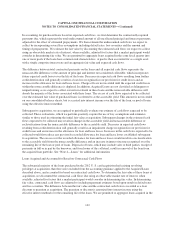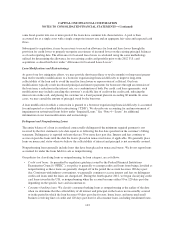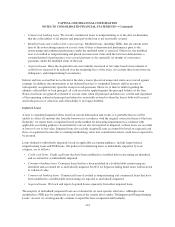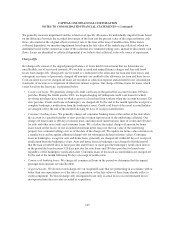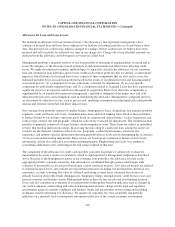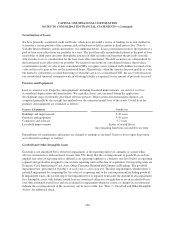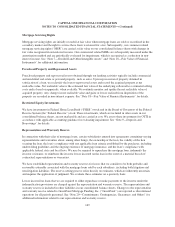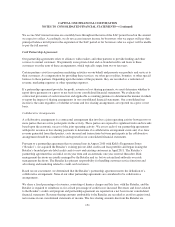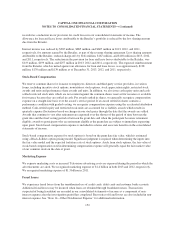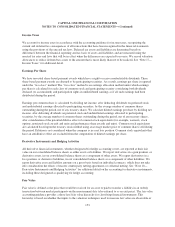Capital One 2013 Annual Report Download - page 167
Download and view the complete annual report
Please find page 167 of the 2013 Capital One annual report below. You can navigate through the pages in the report by either clicking on the pages listed below, or by using the keyword search tool below to find specific information within the annual report.CAPITAL ONE FINANCIAL CORPORATION
NOTES TO CONSOLIDATED FINANCIAL STATEMENTS—(Continued)
The component of the allowance for commercial loans that we collectively evaluate for impairment is based on
our historical loss experience for loans with similar risk characteristics and consideration of the current credit
quality of the portfolio, which is supplemented by management judgment as described above. We apply internal
risk ratings to commercial loans, which we use to assess credit quality and derive a total loss estimate based on
an estimated probability of default (default rate) and loss given default (loss severity). Management may also
apply judgment to adjust the loss factors derived, taking into consideration both quantitative and qualitative
factors, including general economic conditions, specific industry and geographic trends, portfolio concentrations,
trends in internal credit quality indicators and current and past underwriting standards that have occurred but are
not yet reflected in the historical data underlying our loss estimates.
The asset-specific component of the allowance covers smaller-balance homogeneous credit card and other
consumer loans whose terms have been modified in a TDR and larger balance nonperforming, non-homogeneous
commercial loans. As discussed above under “Impaired Loans,” we generally measure the asset-specific
component of the allowance based on the difference between the recorded investment of individually impaired
loans and the present value of expected future cash flows. When the present value is lower than the carrying
value of the loan, impairment is recognized through the provision for credit losses. If the loan is collateral
dependent, we measure impairment based upon the fair value of the underlying collateral, which we determine
based on the current fair value of the collateral less estimated selling costs, instead of discounted cash flows. The
asset-specific component of the allowance for smaller-balance impaired loans is calculated on a pool basis using
historical loss experience for the respective class of assets. The asset-specific component of the allowance for
larger-balance commercial loans is individually calculated for each loan. Key considerations in determining the
allowance include the borrower’s overall financial condition, resources and payment history, prospects for
support from financially responsible guarantors, and when applicable, the estimated realizable value of any
collateral.
We record all purchased loans at fair value at acquisition. Applicable accounting guidance prohibits the carry
over or creation of valuation allowances in the initial accounting for impaired loans acquired in a transfer.
Subsequent to acquisition, decreases in expected principal cash flows of Acquired Loans would trigger the
recognition of impairment through our provision for credit losses. Subsequent increases in expected cash flows
would first result in a recovery of any previously recorded allowance for loan and lease losses, to the extent
applicable, and then increase the accretable yield. Write-downs on purchased impaired loans in excess of the
nonaccretable difference are charged against the allowance for loan and lease losses. See “Note 4—Loans” for
information on loan portfolios associated with acquisitions.
In addition to the allowance for loan and lease losses, we also estimate probable losses related to contractually
binding unfunded lending commitments, such as letters of credit and financial guarantees, and binding unfunded
loan commitments. The provision for unfunded lending commitments is included in the provision for credit
losses on our consolidated statements of income and the related reserve for unfunded lending commitments is
included in other liabilities on our consolidated balance sheets. Unfunded lending commitments are subject to
individual reviews and are analyzed and segregated by risk according to our internal risk rating scale. We assess
these risk classifications, in conjunction with historical loss experience, utilization assumptions, current
economic conditions, performance trends within specific portfolio segments and other pertinent information to
estimate the reserve for unfunded lending commitments.
Determining the appropriateness of the allowance is complex and requires judgment by management about the
effect of matters that are inherently uncertain. Subsequent evaluations of the loan portfolio, in light of the factors
then prevailing, may result in significant changes in the allowance for loan and lease losses and the reserve for
unfunded lending commitments in future periods.
147







